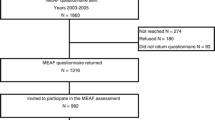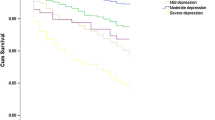Abstract
Background
Studies on the treatment of depression using epidemiological survey methods suggest a high level of under-treatment. Little is known about the characteristics of those people receiving treatment and indeed what kind of treatment they are likely to receive.
Method
Analysis of the data of a statutory health insurance company in Germany.
Results
In middle-aged groups, about 50% of those diagnosed as being depressed in outpatient care are prescribed antidepressants and/or psychotherapy in the course of a year. There is more pharmacologic treatment provided in rural areas and more psychotherapy in cities, suggesting that treatment is dependent upon service availability rather than evidence-based treatment decisions. Treatment rates are considerably lower in the very young and the very old and show gender bias. Young females receive less pharmacologic treatment than young males, and elderly men are, in general, treated less than women, suggesting under-treatment at least for these groups.
Conclusions
The low treatment rates following the diagnosis of depression in the young and the old require attention, in particular with respect to gender aspect.




Similar content being viewed by others
Notes
Only one main diagnosis can be coded for patients admitted to hospital. It usually indicates the main reason for admission. Beyond this, numerous secondary diagnosis can be added, indicating comorbidity
References
Alonso J, Angermeyer M, Bernert S, Bruffaerts R, Brugha T, Bryson H, de Giralamo G, de Graaf R, Demyttenaere K, Gasquet I, Haro J, Katz S, Kessler R, Kovess V, Lepine J, Ormel J, Polidori G, Rousso J, Vilagut G (2004) Psychotropic drug utilization in Europe: results from the European study of the epistemology of mental disorders (ESEMeD) project. Acta Psychiatr Scand 109(Suppl 420):55–64
Alonso J, Angermeyer M, Bernert S, Bruffaerts R, Brugha T, Bryson H, de Giralamo G, de Graaf R, Demyttenaere K, Gasquet I, Haro J, Katz S, Kessler R, Kovess V, Lepine J, Ormel J, Polidori G, Rousso J, Vilagut G (2004) Use of mental health services in Europe: results from the European study of the epidemiology of mental disorders (ESEMeD) project. Acta Psychiatr Scand 109(Suppl 420):47–54
Andrews G, Sanderson K, Corry J, Lapsley H (2000) Using epidemiological data to model efficiency in reducing the burden of depression. J Ment Health Policy Econ 3:175–186
Bramesfeld A, Grobe T, Schwartz F (2007) Who is diagnosed as suffering from depression in the German statutory health care system? An analysis of health insurance data. Euro J Epidemiology DOI 10.1007/s10654-007-9128-z
Busch S, Leslie D, Rosenheck R (2004) Measuring quality of psychopharmacotherapy for depression in a national health care system. Med Care 42:532–542
Busse R, Riesberg A (2004) Health care systems in transition: Germany. Copenhagen WHO regional office for Europe on behalf of the European observatory on health systems and policies
Fegert J, Kölch M, Zito J, Glaeske G, Janhsen K (2006) Antidepressants use in children and adolescents in Germany. J Clin Child Adolesc Psychopharmacol 16:197–206
Fernández A, Haro J, Martinez-alonso K, Demyttenaere K, Brugha T, Autonell G, de Giralamo G, Bernert S, Lépine J, Alonso J (2007) Treatment adequacy for anxiety and depressive disorders in six European countries. Br J Psychiatry 190:172–173
Fiedler G (2005) Suizide, Suizidversuche und Suizidalität in Deutschland. Daten und Fakten 2003. http://www.uke.uni-hamburg.de/extern/tzs/online-text/daten.pdf
Freudenstein U, Jagger C, Arthur A, Donner-Banzhoff N (2001) Treatment for late life depression in primary care—a systematic review. Fam Pract 18:321–327
Friemel S, Bernert S, Angermeyer M, König H (2005) Die direkten Kosten von depressiven Erkrankungen in Deutschland. Ergebnisse aus dem European study of the epidemiology of mental disorders (ESEMeD) Projekt. Psych Prax 32:113–121
Grobe T, Bramesfeld A, Schwartz F (2006) Versorgungsgeschehen. Analyse von Krankenhausdaten. In: Stoppe G, Bramesfeld A, Schwartz F (eds) Volkskrankheit Depression? Bestandsaufnahme und Perspektiven. Springer, Berlin, Heidelberg, pp 39–98
Grobe T, Dörning H, Schwartz F (2004) GEK-Gesundheitsreport 2004. Schwerpunktthema: Gesundheitsstörungen durch Alkohol. St. Augustin Asgard-Verlag
Harrington R, Whittaker J, Shoebridge P, Campbell F (1998) Systematic review of efficacy of cognitive behavior therapy in childhood and adolescent depressive disorder. BMJ 23:1559–1563
Hazell P, O’Connell D, Heathcote D, Henry D (2004) Trizyclic drugs for depression in children and adolescents. The Cochrane Library
Hunkeler E, Katon W, Tang L, Williams J, Kroenke K, Lin E, Harpole L, Arean P, Levine S, Grypma L, Hargreaves W, Unützer J (2006) Long term outcomes from the IMPACT randomised trial for depressed elderly patients in primary care. BMJ 332:259–263
Kessler R, Demler O, Frank R, Olfson M, Pincus H, Walters E, Wang P, Wells K, Zaslavsky A (2005) Prevalence and treatment of mental disorders, 1990 to 2003. N Engl J Med 352: 2515–2523
Murray C, Lopez A (1997) Alternative projections of mortality and disability by cause 1990–2020: global burden of disease study. Lancet 349:1498–1504
Oldehinkel A, Wittchen H-U, Schuster P (1999) Prevalence, 20-month incidence and outcome of unipolar depressive disorders in a community sample of adolescents. Psychol Med 29:655–668
Ostler K, Thompson C, Kinmonth A-L, Peveler R, Stevens L, Stevens A (2001) Influence of socio-economic deprivation on the prevalence and outcome of depression in primary care. The Hampshire depression project. Br J Psychiatry 178:12–17
Palsson S, Östling S, Skoog I (2001) The incidence of first-onset depression in a population followed from the age 70 to 85. Psychol Med 31:1159–1168
Parikh S, Lesage A, Kennedy S, Goering P (1999) Depression in Ontario: under-treatment and factors related to antidepressant use. J Affect Dis 67–76
Regier D, Farmer M, Rae D, Myers J, Kramer M, Robins L, George L, Karno M, Locke B (1993) One-month prevalence of mental disorders in the United States and sociodemographic characteristics: the epidemiologic catchment area study. Acta Psychiatr Scand 88:35–47
Sachverständigenrat für die Konzertierte Aktion im Gesundheitswesen (2001) Depressive Störungen. In: Gutachten 2000/2001: Bedarfsgerechtigkeit und Wirtschaftlichkeit, Ausführliche Zusammenfassung. Sachverständigenrat für die Konzertierte Aktion im Gesundheitswesen, pp 169–177
Stordal E, Mykletun A, Dahl A (2003) The association between age and depression in the general population: a multivariate examination. Acta Psychiatr Scand 107:132–142
Whittington C, Kendall T, Fonagy P, Cotrell D, Cotgrove A, Boddington E (2004) Selective serotonin reuptake inhibitors in childhood depression: systematic review of published versus unpublished data. Lancet 363:11341–11345
Wittchen H-U, Hofler M, Meister W (2001) Prevalence and recognition of depressive syndromes in German primary care settings: poorly recognized and treated? Int Clin Psychopharmacol 16:121–135
Wittchen H-U, Jacobi F (2006) Epidemiologie. In: Stoppe G, Bramesfeld A, Schwartz F (eds) Volkskrankheit Depression? Bestandsaufnahme und Perspektiven. Springer, Berlin, Heidelberg, pp 15–37
Wittchen H-U, Müller N, Pfisterer H, Winter S, Schmidtkurz B (1999) Affektive, somatoforme und Angsstörungen in Deutschland—Erste Ergebnisse des bundesweiten Zusatzsurveys “Psychische Störungen”. Gesundheitswesen 61:216–222
Author information
Authors and Affiliations
Corresponding author
Rights and permissions
About this article
Cite this article
Bramesfeld, A., Grobe, T. & Schwartz, F.W. Who is treated, and how, for depression?. Soc Psychiat Epidemiol 42, 740–746 (2007). https://doi.org/10.1007/s00127-007-0225-9
Accepted:
Published:
Issue Date:
DOI: https://doi.org/10.1007/s00127-007-0225-9




